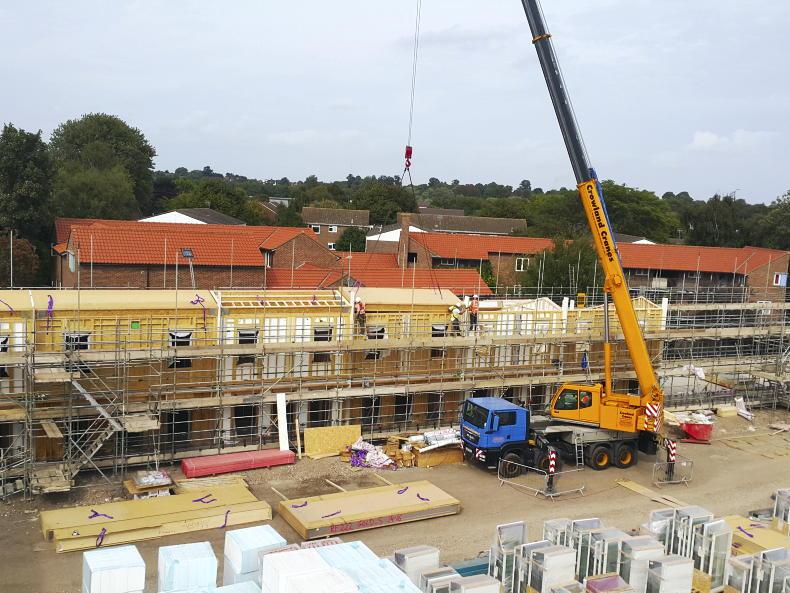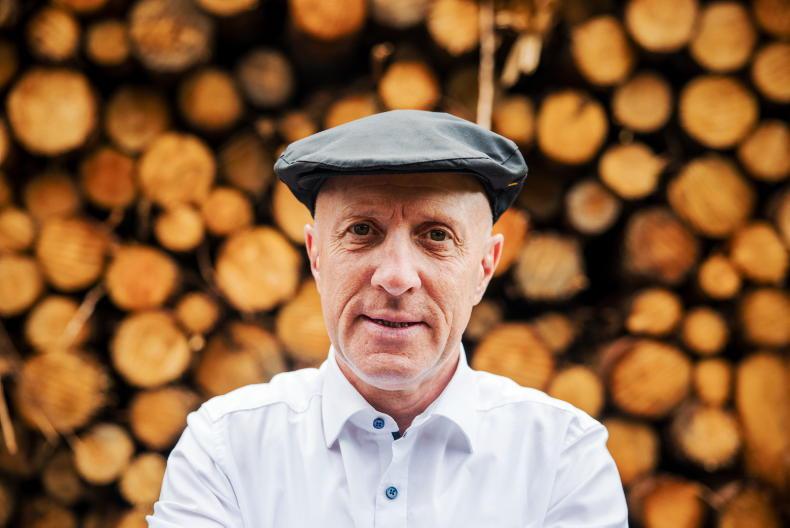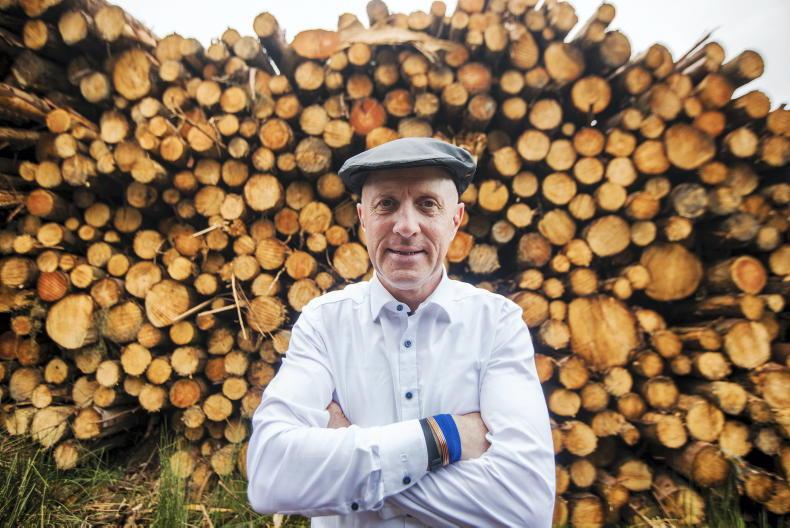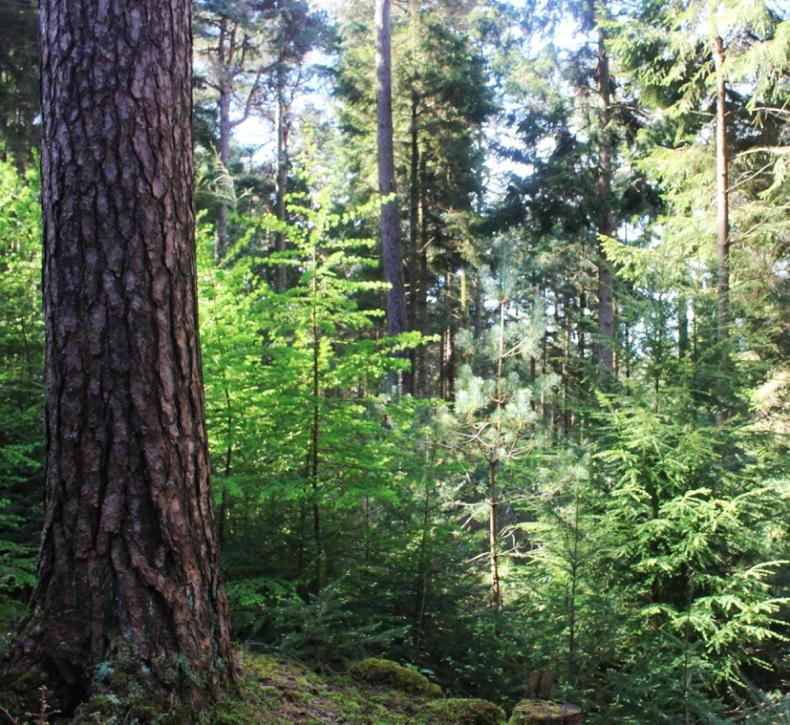The findings of the latest Intergovernmental Panel on Climate Change (IPCC) Report will dictate that climate will be the driving policy issue for forestry, not just for the duration of CAP (2023 to 2027) but well into the century.
The IPCC report warns of the dangers of crossing the global warming level of 1.5°C in the next two decades.
“Unless there are immediate, rapid and large-scale reductions in greenhouse gas emissions, limiting warming to close to 1.5°C or even 2°C will be beyond reach,” it states.
The next report is due in 2022 when CAP is about to be finalised. The EU aims to be a global leader in climate change mitigation and CAP will reflect this.
In doing so, it will be cognisant of the IPCC’s inclusion of afforestation, reforestation and soil carbon management as key measures in global carbon dioxide removal (CDR).
The European Green Deal and the Commission’s proposals to reach 55% GHG emission reductions by 2030 demonstrates intent. The EU draft Forestry Strategy includes a plan to plant 3bn trees across Europe also by 2030.
Afforestation will help our cause
There are opportunities here for Irish forestry – especially afforestation – which is acknowledged as a key area in decarbonising the economy.
Globally, the drive to increase afforestation can have a detrimental impact on agriculture but this is not the case in Ireland as wood security is not at the expense of food security.
Ireland is the only member state with potential to sustainably increase forest cover by 60% by the middle of this century without negatively affecting agricultural production.
Organisations including the Society of Irish Foresters and the Irish Timber Growers Association believe that full integration of forestry within Irish agriculture – and Ireland’s CAP Strategic Plan (CSP) – is essential in order to deliver a viable forestry programme that is not only compatible with agriculture, but also capable of assisting agriculture in reducing GHG emissions.
Who will influence this integration is unclear, as forestry is not represented on the CAP consultative committee. So far, forestry has hardly featured in the “virtual town hall” public consultation meetings organised by the Department of Agriculture, Food and the Marine on Ireland’s CSP.
Forestry not a priority
This is not surprising as forestry is not a priority in a Department mainly concerned with agriculture and food. Ireland’s future 8,000ha annual afforestation programme was set by Ireland’s Climate Action Plan, not by the Department of Agriculture.
In addition, Irish forestry is outside the remit of CAP for funding purposes. It has been funded solely by the exchequer since 2007 after two decades of EU support; a decision the Department has never fully explained.
The disconnect between forestry and agriculture is most obvious in the Department’s draft swot analysis for Ireland’s CAP Strategic Plan, which is extremely weak on production sustainable forestry.
Instead, issues such as hedgerow and “non-forest woodland” receive strong prominence. These have undoubted biodiversity and sequestration benefits but will contribute nothing to decarbonising construction, a major GHG emitter.
The Teagasc forest carbon tool (FCT) demonstrates this as the carbon sequestration benefits of broadleaves fall well below conifers when forest site sequestration, harvested wood products and energy substitution are factored in.
For example, the FCT shows that a forest comprising 70% Sitka spruce and 30% broadleaves has a mean sequestration rate of 6.58t CO2/ha. A woodland comprising 85% oak and other broadleaves has a mean sequestration rate of 1.96t CO2/ha. The Department’s swot analysis ignores the FCT.
Balance to support incomes
When maximising the carbon sequestration, wood production, biodiversity and other non-wood benefits of forestry, the answer lies in aiming for a balanced programme where farmers who opt to plant receive an income from their forests, as well as enjoying other non-wood benefits.
In this regard, forestry will not only have to be compatible with other farming enterprises, but it will also have to compete with these in delivering a sustainable family farm income.
Otherwise, most of the investment in new forests will be carried out by non-farmers, as has been happening in recent years. Farmers will need convincing of the economic worth of forestry.
The financial returns from forestry stand up well in comparison with other farm systems as researched by Teagasc (Figure 1).
High-production Sitka spruce yield class (YC) 24 (m3/ha/annum) provides an annual income of €602/ha, well above cattle rearing or suckler cow production (€428/ha), cattle fattening (€462/ha) and sheep (€382/ha). Even medium-yield forests are capable of providing an annual income of €415/ha.
Forestry income is based on 100% commercial forestry which is no longer approved for grant aid. The requirement now is to provide 30% native broadleaves and open spaces, which reduces income considerably over crop rotations.
The obvious way to compensate forest owners with mixed species woodland is to provide a carbon payment for income foregone for managing long-rotation native woodland for their non-wood carbon benefits. Otherwise, the switch to forestry by some suckler farmers is unlikely, although their income too is likely to be reduced under Ireland’s CSP.
For example, the Department’s Carbon Efficiency Programme, aimed at reducing green house gas emissions, is likely to cap suckler cow numbers from 2023. Early indications are that a suckler farmer with 40ha of entitlements could see payments fall by 35% from €473/ha to €309/ha under CAP.
A forestry and farm programme
One solution is a compatible forestry and farm programme involving the transfer of some marginal land to forestry. In the case of the 40ha suckler cow farmer, a transfer of 10ha to forestry could provide an income of over €6,000 from forestry, while the remaining 30ha could receive an income of €14,000 through an innovative carbon efficiency scheme, which acknowledges the farmer’s role in climate change mitigation by switching from agriculture to forestry.
This would also require innovative thinking in ensuring compatibility between agriculture and forestry, in particular incorporating wood and non-wood benefits in the farm enterprise.
This approach would benefit farmers with 1.3m ha of land categorised as marginal or too poor for productive, profitable farming. About 16% of this land (230,000ha) could be made available for planting up to 2050, providing an annual programme of 8,000ha.
However, the onus should not be placed on suckler and sheep farmers alone. There are also opportunities to plant an estimated 4% to 5% or 100,000ha of Ireland’s productive agricultural land bank, estimated at 2.3m ha.
Even on this land there is scope to plant riparian areas, field corners, shelter belts and wet areas, all ideally suited for small-scale forestry. This would add 3,500ha to the annual planting programme.
By spreading afforestation geographically, this approach would provide an annual afforestation programme of 11,500ha, similar to Scotland’s over the past three years. A programme of this scale could be achieved without negatively impacting on agricultural production.
Driving forestry forward
Stuart Goodall, CEO of Confor, the UK organisation that promotes sustainable forestry in Scotland, said that the dramatic increase in afforestation was led by the minister [Fergus Ewing] who took a personal interest and leading role in meeting the target from 2016 to 2021.
“Minister Ewing asked what the barriers were and acted to overcome them, including improving the grant approval process,” Goodall said.
He also encouraged all types of planting to come forward – productive and biodiversity focused.
This leadership is lacking in Ireland as close to 5,000 forestry licences remain unapproved by the Department for up to two years.
A significant portion of these are felling licences (thinning and clearfell) from the private forest owners, mainly farmers.
This licence failure has led to a dramatic decrease in domestic wood mobilisation. Yet, the Department’s swot analysis makes no mention of the licence debacle. Instead, it blatantly states: “Some forests are not managed to their productive potential due to lack of knowledge and awareness among forest owners regarding the management and value of forests.”
Forestry is a multipurpose resource which requires leadership and the establishment of an independent forestry development agency.
Forestry is the only natural resource without the support of such a body, unlike food (Bord Bia), sea fisheries (BIM), environment (EPA) marine research (Marine Institute) and renewable energy (SEI).
The forestry and forest products sector would benefit enormously from the establishment of an independent agency and its parent department would also benefit from having the support of such a body at national and EU level.
Decarbonising the Irish
building industry with wood
Building operations and construction now account for nearly 40% of global energy-related CO2 emissions, according to GlobalABC. Increasing wood use in construction is the key to displacing fossil-based materials. Ireland is ideally placed to increase wood use in construction, as softwood log production is forecast to double over the next 15 years with opportunities to increase timber frame construction in the short term and engineered wood building in the long term.
Timber frame
A timber-framed house uses softwood (spruce and/or pine) in the load-bearing structure throughout the building, as well as oriented strand board (OSB) sheathing material. It looks like a conventional house as the façade can feature masonry or brick. Currently, 85% of all new homes in Scotland use timber frame construction compared with 24% in Ireland.
“Timber-frame structures use significantly more wood than their masonry counterparts,” says Des O’Toole, Forest Industries Ireland (FII). “When comparing the embodied and sequestered carbon storage between a typical timber frame and masonry home, it can be shown the net carbon emissions are reduced by 7.4t CO2 for the structure, which is a 2.5 times emission reduction.”
Engineered wood
Engineered wood construction such as cross laminated timber (CLT) is now used in high-rise construction in Europe in buildings up to 80m tall. Timber accounts for up to 80% of all materials in these buildings. Research work carried out in NUI Galway shows that homegrown Sitka spruce is suitable for CLT production.
The potential to maximise this market in the long term will add to the spruce market range. It will require a change in Ireland’s building regulations to allow buildings higher than 10m to be built primarily in CLT,” according to FII.
Cygnum, the Co Cork-based timber frame construction company, completed 105 ultra-low-energy timber-frame homes for Norwich City Council’s social housing scheme. Using mainly spruce, annual fuel bills average £150 (€165), which helps the council meet its objectives in tackling fuel poverty. \ Cygnum
In brief
There is considerable potential to have a much higher level of afforestation in this country to help in the national effort against climate change. Forestry support needs to take into account the requirement to include less profitable broadleaved species in new plantations.The sector needs to be better coordinated and preferably in association with food production systems. Increased use of softwood (conifer) products is a key element in decarbonising the building industry.
The findings of the latest Intergovernmental Panel on Climate Change (IPCC) Report will dictate that climate will be the driving policy issue for forestry, not just for the duration of CAP (2023 to 2027) but well into the century.
The IPCC report warns of the dangers of crossing the global warming level of 1.5°C in the next two decades.
“Unless there are immediate, rapid and large-scale reductions in greenhouse gas emissions, limiting warming to close to 1.5°C or even 2°C will be beyond reach,” it states.
The next report is due in 2022 when CAP is about to be finalised. The EU aims to be a global leader in climate change mitigation and CAP will reflect this.
In doing so, it will be cognisant of the IPCC’s inclusion of afforestation, reforestation and soil carbon management as key measures in global carbon dioxide removal (CDR).
The European Green Deal and the Commission’s proposals to reach 55% GHG emission reductions by 2030 demonstrates intent. The EU draft Forestry Strategy includes a plan to plant 3bn trees across Europe also by 2030.
Afforestation will help our cause
There are opportunities here for Irish forestry – especially afforestation – which is acknowledged as a key area in decarbonising the economy.
Globally, the drive to increase afforestation can have a detrimental impact on agriculture but this is not the case in Ireland as wood security is not at the expense of food security.
Ireland is the only member state with potential to sustainably increase forest cover by 60% by the middle of this century without negatively affecting agricultural production.
Organisations including the Society of Irish Foresters and the Irish Timber Growers Association believe that full integration of forestry within Irish agriculture – and Ireland’s CAP Strategic Plan (CSP) – is essential in order to deliver a viable forestry programme that is not only compatible with agriculture, but also capable of assisting agriculture in reducing GHG emissions.
Who will influence this integration is unclear, as forestry is not represented on the CAP consultative committee. So far, forestry has hardly featured in the “virtual town hall” public consultation meetings organised by the Department of Agriculture, Food and the Marine on Ireland’s CSP.
Forestry not a priority
This is not surprising as forestry is not a priority in a Department mainly concerned with agriculture and food. Ireland’s future 8,000ha annual afforestation programme was set by Ireland’s Climate Action Plan, not by the Department of Agriculture.
In addition, Irish forestry is outside the remit of CAP for funding purposes. It has been funded solely by the exchequer since 2007 after two decades of EU support; a decision the Department has never fully explained.
The disconnect between forestry and agriculture is most obvious in the Department’s draft swot analysis for Ireland’s CAP Strategic Plan, which is extremely weak on production sustainable forestry.
Instead, issues such as hedgerow and “non-forest woodland” receive strong prominence. These have undoubted biodiversity and sequestration benefits but will contribute nothing to decarbonising construction, a major GHG emitter.
The Teagasc forest carbon tool (FCT) demonstrates this as the carbon sequestration benefits of broadleaves fall well below conifers when forest site sequestration, harvested wood products and energy substitution are factored in.
For example, the FCT shows that a forest comprising 70% Sitka spruce and 30% broadleaves has a mean sequestration rate of 6.58t CO2/ha. A woodland comprising 85% oak and other broadleaves has a mean sequestration rate of 1.96t CO2/ha. The Department’s swot analysis ignores the FCT.
Balance to support incomes
When maximising the carbon sequestration, wood production, biodiversity and other non-wood benefits of forestry, the answer lies in aiming for a balanced programme where farmers who opt to plant receive an income from their forests, as well as enjoying other non-wood benefits.
In this regard, forestry will not only have to be compatible with other farming enterprises, but it will also have to compete with these in delivering a sustainable family farm income.
Otherwise, most of the investment in new forests will be carried out by non-farmers, as has been happening in recent years. Farmers will need convincing of the economic worth of forestry.
The financial returns from forestry stand up well in comparison with other farm systems as researched by Teagasc (Figure 1).
High-production Sitka spruce yield class (YC) 24 (m3/ha/annum) provides an annual income of €602/ha, well above cattle rearing or suckler cow production (€428/ha), cattle fattening (€462/ha) and sheep (€382/ha). Even medium-yield forests are capable of providing an annual income of €415/ha.
Forestry income is based on 100% commercial forestry which is no longer approved for grant aid. The requirement now is to provide 30% native broadleaves and open spaces, which reduces income considerably over crop rotations.
The obvious way to compensate forest owners with mixed species woodland is to provide a carbon payment for income foregone for managing long-rotation native woodland for their non-wood carbon benefits. Otherwise, the switch to forestry by some suckler farmers is unlikely, although their income too is likely to be reduced under Ireland’s CSP.
For example, the Department’s Carbon Efficiency Programme, aimed at reducing green house gas emissions, is likely to cap suckler cow numbers from 2023. Early indications are that a suckler farmer with 40ha of entitlements could see payments fall by 35% from €473/ha to €309/ha under CAP.
A forestry and farm programme
One solution is a compatible forestry and farm programme involving the transfer of some marginal land to forestry. In the case of the 40ha suckler cow farmer, a transfer of 10ha to forestry could provide an income of over €6,000 from forestry, while the remaining 30ha could receive an income of €14,000 through an innovative carbon efficiency scheme, which acknowledges the farmer’s role in climate change mitigation by switching from agriculture to forestry.
This would also require innovative thinking in ensuring compatibility between agriculture and forestry, in particular incorporating wood and non-wood benefits in the farm enterprise.
This approach would benefit farmers with 1.3m ha of land categorised as marginal or too poor for productive, profitable farming. About 16% of this land (230,000ha) could be made available for planting up to 2050, providing an annual programme of 8,000ha.
However, the onus should not be placed on suckler and sheep farmers alone. There are also opportunities to plant an estimated 4% to 5% or 100,000ha of Ireland’s productive agricultural land bank, estimated at 2.3m ha.
Even on this land there is scope to plant riparian areas, field corners, shelter belts and wet areas, all ideally suited for small-scale forestry. This would add 3,500ha to the annual planting programme.
By spreading afforestation geographically, this approach would provide an annual afforestation programme of 11,500ha, similar to Scotland’s over the past three years. A programme of this scale could be achieved without negatively impacting on agricultural production.
Driving forestry forward
Stuart Goodall, CEO of Confor, the UK organisation that promotes sustainable forestry in Scotland, said that the dramatic increase in afforestation was led by the minister [Fergus Ewing] who took a personal interest and leading role in meeting the target from 2016 to 2021.
“Minister Ewing asked what the barriers were and acted to overcome them, including improving the grant approval process,” Goodall said.
He also encouraged all types of planting to come forward – productive and biodiversity focused.
This leadership is lacking in Ireland as close to 5,000 forestry licences remain unapproved by the Department for up to two years.
A significant portion of these are felling licences (thinning and clearfell) from the private forest owners, mainly farmers.
This licence failure has led to a dramatic decrease in domestic wood mobilisation. Yet, the Department’s swot analysis makes no mention of the licence debacle. Instead, it blatantly states: “Some forests are not managed to their productive potential due to lack of knowledge and awareness among forest owners regarding the management and value of forests.”
Forestry is a multipurpose resource which requires leadership and the establishment of an independent forestry development agency.
Forestry is the only natural resource without the support of such a body, unlike food (Bord Bia), sea fisheries (BIM), environment (EPA) marine research (Marine Institute) and renewable energy (SEI).
The forestry and forest products sector would benefit enormously from the establishment of an independent agency and its parent department would also benefit from having the support of such a body at national and EU level.
Decarbonising the Irish
building industry with wood
Building operations and construction now account for nearly 40% of global energy-related CO2 emissions, according to GlobalABC. Increasing wood use in construction is the key to displacing fossil-based materials. Ireland is ideally placed to increase wood use in construction, as softwood log production is forecast to double over the next 15 years with opportunities to increase timber frame construction in the short term and engineered wood building in the long term.
Timber frame
A timber-framed house uses softwood (spruce and/or pine) in the load-bearing structure throughout the building, as well as oriented strand board (OSB) sheathing material. It looks like a conventional house as the façade can feature masonry or brick. Currently, 85% of all new homes in Scotland use timber frame construction compared with 24% in Ireland.
“Timber-frame structures use significantly more wood than their masonry counterparts,” says Des O’Toole, Forest Industries Ireland (FII). “When comparing the embodied and sequestered carbon storage between a typical timber frame and masonry home, it can be shown the net carbon emissions are reduced by 7.4t CO2 for the structure, which is a 2.5 times emission reduction.”
Engineered wood
Engineered wood construction such as cross laminated timber (CLT) is now used in high-rise construction in Europe in buildings up to 80m tall. Timber accounts for up to 80% of all materials in these buildings. Research work carried out in NUI Galway shows that homegrown Sitka spruce is suitable for CLT production.
The potential to maximise this market in the long term will add to the spruce market range. It will require a change in Ireland’s building regulations to allow buildings higher than 10m to be built primarily in CLT,” according to FII.
Cygnum, the Co Cork-based timber frame construction company, completed 105 ultra-low-energy timber-frame homes for Norwich City Council’s social housing scheme. Using mainly spruce, annual fuel bills average £150 (€165), which helps the council meet its objectives in tackling fuel poverty. \ Cygnum
In brief
There is considerable potential to have a much higher level of afforestation in this country to help in the national effort against climate change. Forestry support needs to take into account the requirement to include less profitable broadleaved species in new plantations.The sector needs to be better coordinated and preferably in association with food production systems. Increased use of softwood (conifer) products is a key element in decarbonising the building industry. 









SHARING OPTIONS